- A Guide on Using AI Agents to Write Job Descriptions (Without Losing the Human Touch) - December 1, 2025
- Why Job Description Accuracy Isn’t Optional (And How to Get It Right) - October 27, 2025
- 15 HR Pros Share Their Tips for Writing Job Descriptions - October 1, 2025
Accurate job descriptions are your handshake with the recruiting world. When they’re wrong, you’re not just confusing candidates you’re sabotaging your entire hiring process.
And good JDs not only positively affect your recruitment process, but they also influence the success of various areas in your organization. Here’s how:
Job Description Accuracy Improves Candidate Selection and Hiring
Well-detailed job descriptions positively influence your hiring process in some of these ways:
Promotes Positive Candidate Experience
A well-written JD serves as the first step toward a positive candidate experience by providing clear information. Vague JDs result in a poor candidate experience because they set the wrong expectations.
For instance, if your job description states that your organization is looking for a product designer with Figma skills, but during the interview process, you mention Adobe skills as the main requirement, it can confuse the candidate. This ruins the whole candidate experience, and you end up failing to hire any qualified candidate.
Helps Attract and Hire the Right Candidates
One of the biggest recruiting challenges year in, year out is attracting the right candidates to hire. And this challenge starts because of a poor JD.
The clearer and detailed the JD is, the better it is at attracting qualified applicants. So, write a clear job title and state the must-have requirements to get your ideal candidate. And use clear language to outline the responsibilities.
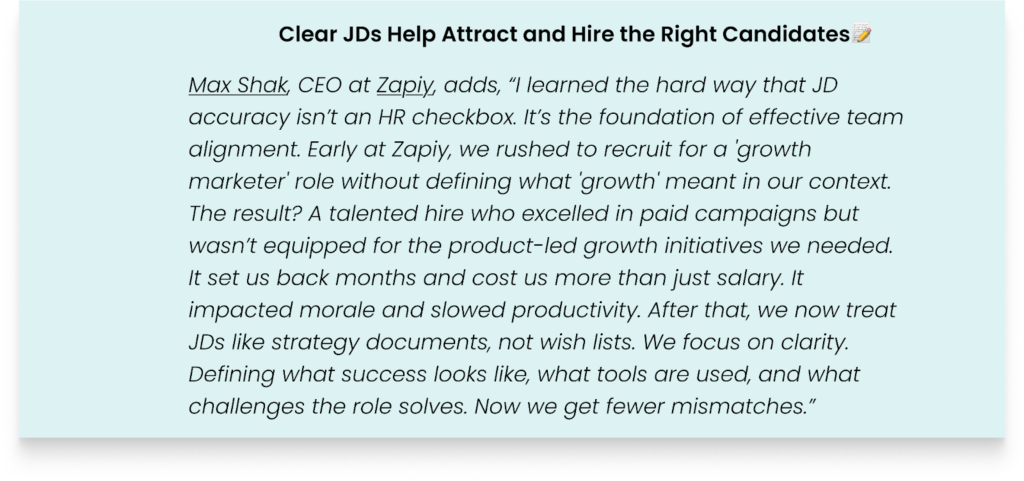
Max Shak, CEO at Zapiy, adds, “I learned the hard way that JD accuracy isn’t an HR checkbox. It’s the foundation of effective team alignment.
Early at Zapiy, we rushed to recruit for a ‘growth marketer’ role without defining what ‘growth’ meant in our context. The result? A talented hire who excelled in paid campaigns but wasn’t equipped for the product-led growth initiatives we needed. It set us back months and cost us more than just salary. It impacted morale and slowed productivity. After that, we now treat JDs like strategy documents, not wish lists. We focus on clarity. Defining what success looks like, what tools are used, and what challenges the role solves. Now we get fewer mismatches.”
Improves Candidates’ Filtering Process
Good job descriptions serve as a filtering tool because candidates can see whether they’re qualified to apply. This saves you the time you’d spend filtering resumes to identify suitable candidates. While vague JDs attract all types of candidates, especially the unqualified ones.
To successfully filter your applicants, outline all the must-have requirements and responsibilities for the open role. This allows any job seeker to analyze if their experience and skills fit the role.
Job Description Accuracy Improves Performance Management Process
An accurate JD serves as the foundation for a comprehensive performance management evaluation process in some of these ways:
Used as a Basis for Fair Evaluation
Job descriptions act as a guide to assess employees’ performance. You can use the job description requirements and responsibilities to gauge whether the employee meets those details.
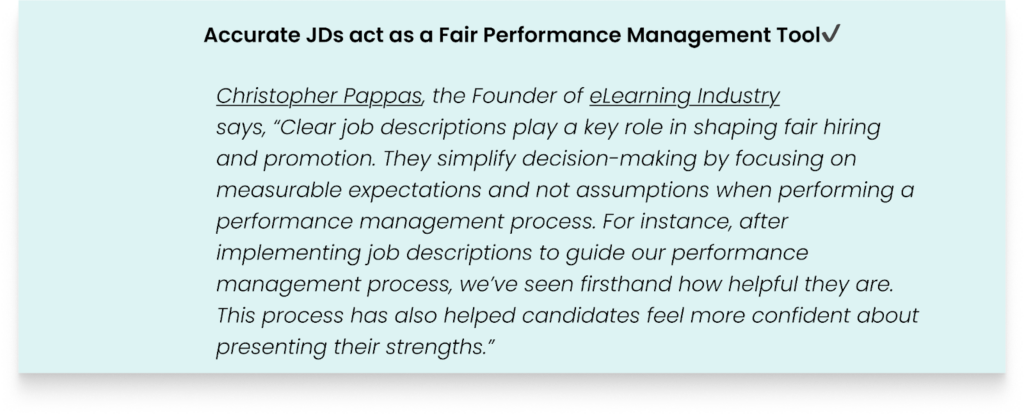
Christopher Pappas, the Founder of eLearning Industry
says, “Clear job descriptions play a key role in shaping fair hiring and promotion. They simplify decision-making by focusing on measurable expectations and not assumptions when performing a performance management process. For instance, after implementing job descriptions to guide our performance management process, we’ve seen firsthand how helpful they are. This process has also helped our employees feel more confident about presenting their strengths.”
Sets Clear Expectation Between the Employee and Employer
Accurate JDs play a crucial role in enabling both the employer and employees to have an understanding of what’s required from each other.
And building these realistic expectations positively affects the entire organization’s working experience. You’ll find your organization having low turnover rates, increased productivity, and improved teamwork. Because each one knows what’s expected of them.
Job Description Accuracy Helps With Discrimination and Regulatory Compliance
Well-written job descriptions act as a compliance tool. And they also discourage any form of intentional or unintentional bias. Here’s how:
Prevents Various Forms of Discriminatory Language
Accurate job descriptions are written to ensure no candidate gets offended by the language used. For example, the JDs are usually free from:
- Unconscious gender bias: A detailed JD uses gender-inclusive terms for both men and women. For instance, the JD avoids words such as “leader” and “competitive” because they prevent female applicants from applying to any job opening.
- Racial bias: An accurate JD avoids excluding any applicants based on their culture, race, or nationality. For instance, you won’t find the JD having terms such as “cakewalk” and “grandfather clause” since they are discriminatory towards black applicants.
- Unconscious age bias: A good job description uses age-inclusive terms that don’t affect any candidate based on their age. Whether young or old.
Resolving Employment Disputes
Good job descriptions serve as a defense during legal employee disputes.
They can serve as a critical tool in cases related to work practices by providing detailed evidence of job description responsibilities. And the information that was communicated to prospective workers in the JD document.
Compliance with Employment Laws
Accurate JDs are an important tool in ensuring compliance with different labor laws.
For instance, a good JD ensures compliance with laws related to accommodations for people living with disabilities, such as the Americans with Disabilities Act (ADA) and labor laws that advocate for equal employment opportunities.
And with good job descriptions, you naturally find that you’ve complied with all laws. By doing this, you create an inclusive working culture.
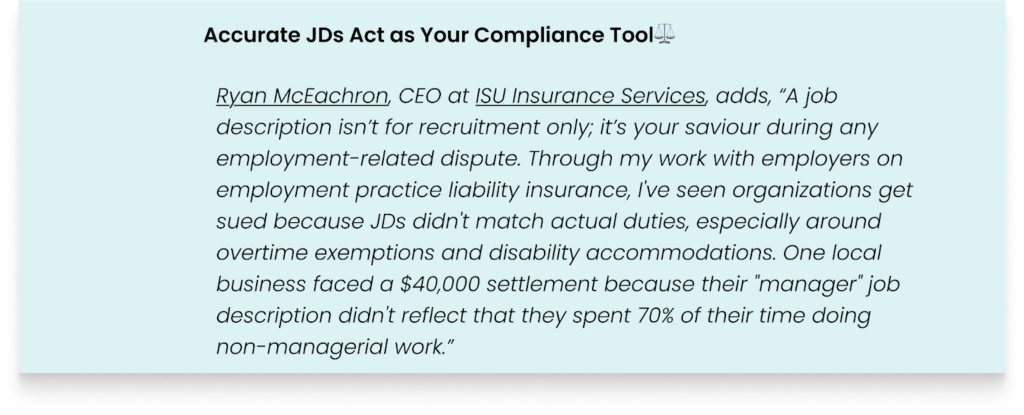
Ryan McEachron, CEO at ISU Insurance Services, adds, “A job description isn’t for recruitment only; it’s your saviour during any employment-related dispute. Through my work with employers on employment practice liability insurance, I’ve seen organizations get sued because JDs didn’t match actual duties, especially around overtime exemptions and disability accommodations. One local business faced a $40,000 settlement because their “manager” job description didn’t reflect that they spent 70% of their time doing non-managerial work.”
Job Description Accuracy Enhances Fair Compensation
Writing accurate JDs helps an organization create the correct salary range for any role. Here’s how:
Detailed Role Evaluation
Well-written JDs provide a comprehensive understanding of the job opening. This way, you can see the responsibilities, experience, and the time it takes to succeed in such a role.
And because of this, you’ll manage to research and get to know the fair salary range for that role.
Moreover, with a detailed JD, it’s easy to price the job opening using third-party compensation data tools. Plus, from a LinkedIn study, 61% of candidates consider salary range as a crucial factor in job descriptions. So if you write the wrong salary range in your JDs, no qualified candidate will apply.
Read also: Mini Experiments: Testing Salary Ranges on Job Postings
Job Description Accuracy Boosts Employee Engagement
Creating inconsistent job descriptions leads to low employee morale, high turnover rate, and reduced employee productivity. And this is because once employees start working, they realize that the details in the job description differ from what they’re supposed to work on.
On the other hand, a well-written job description enhances employee engagement in these ways:
Defined Role, Key Responsibilities, and Skills
A good JD sets the expectations for any qualified candidate by stating what’s required of them. Once they begin their duties, they are sure of their key day-to-day duties. This leads to satisfaction with their daily responsibilities.
For instance, if the JD describes that the company is looking for a designer, and once the employee starts working and finds that all their duties are about design, they’ll be more engaged with their daily duties.
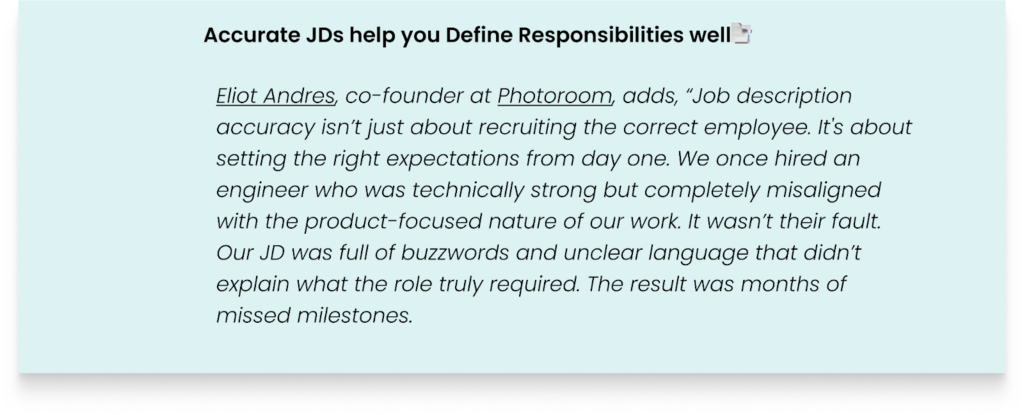
Eliot Andres, co-founder at Photoroom, adds, “Job description accuracy isn’t just about recruiting the correct employee. It’s about setting the right expectations from day one. We once hired an engineer who was technically strong but completely misaligned with the product-focused nature of our work. It wasn’t their fault. Our JD was full of buzzwords and unclear language that didn’t explain what the role truly required. The result was months of missed milestones.
We fixed this by making our JD writing process collaborative. Every new JD now involves input from employees already doing similar work. They help describe what “a great day” looks like in that open position, like the key skills, responsibilities, purpose, and impact. This made our hiring far more accurate and improved team chemistry.”
Well-Written Purpose
Employees want to understand how the job connects to a greater mission. So whichever mission connects to the job, write it.
It doesn’t matter what the mission is; it could be solving a worldwide problem or just helping your customers lead a better life.
You can describe the purpose in your mission statement and place it clearly for potential candidates to see it.
And once the worker starts working and sees how their work contributes to the company’s mission, they become emotionally attached to fulfilling the purpose.

Victor Riparbelli, ceo at Synthesia, adds, “My tip is to think of a job description as your company’s promise to a future teammate. Make it honest, specific, and inspiring. When people know exactly what part they play in the bigger story, they perform with confidence, and that’s where the real magic happens.”
What an Accurate Job Description Looks Like
So, here’s a checklist to maintain and publish an accurate job description:
- Have a Clear and updated Job Title: Avoid funny titles such as “growth ninja” and “rockstar”. Let the role you’re looking to hire for guide the title. For instance, if you’re looking for a content manager, write content manager, not rockstar content manager
- Job Summary: Include a job description summary to give applicants an idea of the open position without going into many details yet.
- About Us or Mission Statement: Talk about your organization and what it’s like to work there. Share your organization’s culture and also highlight interesting information about what it is like to work for your team.
- Write Specific Responsibilities: Avoid vague explanations of responsibilities. Let the candidate understand their day-to-day, weekly, and monthly tasks.
- Include Required and Preferred Skills: Let any potential applicant reading the job description see if they possess all the must-have skills before applying.
- Include Must-Have and Nice-to-Have Requirements: State the requirements the candidates must have before clicking the apply button. For instance, if it’s a must-have for them to have studied a certain course, write that.
- State the Salary Range: Candidates want to know if the role pays fairly for those responsibilities.
- Use Clear and Inclusive Language: Use clear language and avoid any confusing terms. The language must also not discriminate against any type of candidate.
- Highlight the Benefits: State any important benefits and perks you offer. For instance, do you provide any insurance, etc?
- Physical Demands and Working Conditions: If there are any must-have physical requirements for the success of the role, include them in the JD so any candidate can know before applying.
By having this checklist, you’ll write and publish a good JD.
Read also: How to Write a Job Description — Best Practices & Examples (2024 Update)
Why Job Descriptions Get Outdated (and Fast)
Here’s where most organizations get it wrong: you write the perfect, accurate JD, but then forget to do continuous updates. In the end, your job descriptions get outdated. Here’s why:
- Changing business requirements: Market needs, new technologies, and changing business priorities change the focus of any job quickly. And this builds a disconnect between what’s in the job description and what the candidate has to do.
- No JD update ownership process: Most teams write the JD and forget to have someone whose work is to streamline the process of updating all JDs.
- Job duties change rapidly: Jobs change over time. So the duties listed in the JD require updates to reflect the current responsibilities.
So, to understand how to create a good JD update process, read the section below.
How to Keep Job Descriptions Accurate Without Losing Your Mind
Maintaining JD’s accuracy isn’t easy. And it becomes more challenging if you’re dealing with many job descriptions. To make this accuracy update process easy, implement these tips:
- Schedule Quarterly or Bi-Annual Edits
A job description is just like a “living document”. So create a strategy to decide on the timeframe you’ll perform JD reviews and edits. It could be after three months, six months, or a year.
- Use a Job Description Management Software
A job description tool simplifies the process of updating an accurate JD by centralizing all reviews and updates. These tools also provide version control capabilities to simplify the JD collaboration process.
So you can know who’s supposed to edit which section and during which period they’re supposed to do that. Plus, you can easily see who made changes and the time the changes happened.
For instance, our software, Ongig, gives you efficient user control features that help to:
- Define Role-Based Access Control
Ongig simplifies user permissions by ensuring each person editing the JD document has only specific permissions. This way, you won’t have conflicting updates because each person knows what they’re working on.
- Build an Efficient User Management Process
By using Ongig, you can set an “Administrator” control to manage the user accounts. And if you want any other person or employee to edit the JD, the administrator quickly adds the person without any challenges. This way, you create a good user management process with people having different roles, such as editor, editor plus, and auditor.
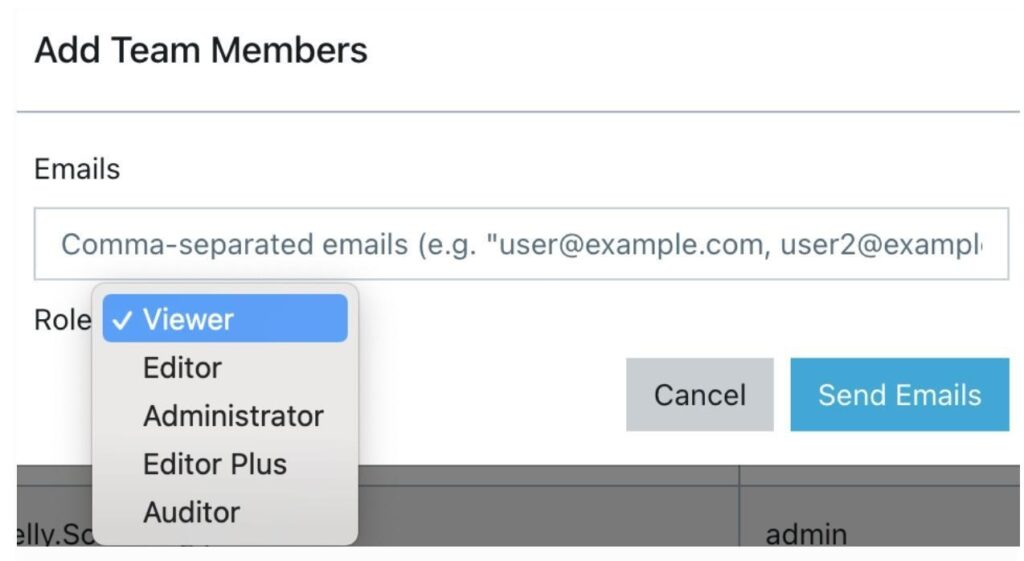
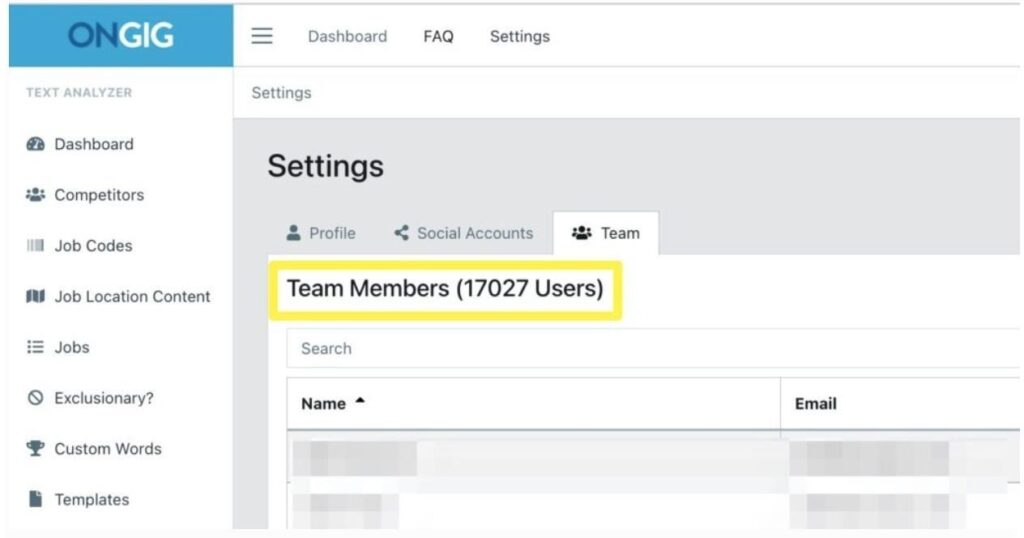
- Assign JD Ownership
Create a structure to ensure there’s a designated person or people for maintaining the accuracy of JDs. This removes the confusion and blame game of who’s responsible for regular updates. So when there’s a need for any JD update, everyone knows who to report to.
- Make Use of Templates
With templates, you don’t have to start updating your JD from scratch every time. Instead, you can use templates to update the section that needs updating. With the templates, you also maintain formatting consistency across all job descriptions.
Read also: Why Updating Job Descriptions Matters More Than You Think
Why I Wrote This
Job description accuracy affects various areas of your organization, from hiring to ensuring compliance to employee engagement. At Ongig, we help you create, maintain, and update JDs using efficient tools that save you time and minimize bias.
So, request a demo today to see how Ongig can make your JDs better (and your life easier).
FAQs: Why Job Description Accuracy isn’t Optional
- What’s the most common mistake in job descriptions?
Overusing jargon and leaving out specifics. Because of this, candidates can’t apply if they don’t understand what you’re asking for.
- How often should job descriptions be updated?
Ideally, every 6 months or when the role or organization undergoes major changes.
- Who should be responsible for job description accuracy?
The HR team is mainly responsible in most organizations. But involving hiring managers is also important to reflect the current scope.
- Can inaccurate job descriptions create legal risks?
Yes. Especially if the JDs don’t include ADA language, pay transparency, or reflect essential job functions.
- How can software help with job description accuracy?
JD tools like Ongig automate updates, highlight biased language, and smooth collaboration between those involved in creating the JD.
